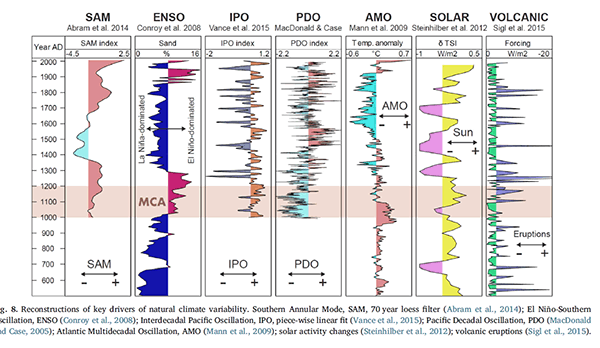http://joannenova.com.au/2019/07/antarctica-was-warmer-one-thousand-years-ago-and-life-was-ok/
By Jo Nova
Remember when polar amplification was the rage? So much for that theory
Antarctica is twice the size of the US or Australia. Buried 2 km deep under domes of snow, it holds 58 meters of global sea level to ransom. The IPCC have been predicting its demise-by-climate-change for a decade or two.
A new paper looks at 60 sites across Antarctica, considering everything from ice, lake and marine cores to peat and seal skins. They were particularly interested in the Medieval Warm Period, and researched back to 600AD. During medieval times (1000-1200 AD) they estimate Antarctica as a whole was hotter than it is today. Antarctica was even warmer still — during the dark ages circa 700AD.
Credit to the paper authors: Sebastian Lüning, Mariusz Gałka, and Fritz Vahrenholt
Feast your eyes on the decidedly not unprecedented modern tiny spike:
The little jaggy down after 2000 AD is real. While there was rapid warming across Antarctica from 1950-2000, in the last twenty years, that warming has stalled. Just another 14 million square kilometers that the models didn’t predict.
We already knew the Medieval Warm Period was a global phenomenon, thanks to hundreds of proxies, and 6,000 boreholes. But this new paper is a great addition.
With an awesome dedication to detail, the team put all the big oceanic and other factors into one big graph. It is nice to see them side by side so we can see the connections between them.
Fig. 8. Reconstructions of key drivers of natural climate variability. Southern Annular Mode, SAM, 70 year loess filter (Abram et al., 2014); El Niño-Southern Oscillation, ENSO (Conroy et al., 2008); Interdecadal Pacific Oscillation, IPO, piece-wise linear fit (Vance et al., 2015); Pacific Decadal Oscillation, PDO (MacDonald and Case, 2005); Atlantic Multidecadal Oscillation, AMO (Mann et al., 2009); solar activity changes (Steinhilber et al., 2012); volcanic eruptions (Sigl et al., 2015).
Main drivers of the multi-centennial scale climate variability appear to be the Southern Annular Mode (SAM) and El Niño-Southern Oscillation (ENSO) which are linked to solar activity changes by nonlinear dynamics. The MCA forms the final part of a long warm phase that dominated the first millennium CE
Looking at different parts of Antarctica some parts cooled while other parts warmed. Many of these “sea-sawing” pairs appear to be flexing as a dipole.
Fig. 4. Temperature development in the Antarctic region during the past 1500 years based on palaeoclimate proxies of selected study sites. 7: Fan Lake (Strother et al., 2015), 25: ODP 1098 (Domack and Mayewski, 1999; Shevenell et al., 2011; Shevenell and Kennett, 2002), 31: Berkner Island (Mulvaney et al., 2002), 45: EPICA Dome C (Masson-Delmotte et al., 2004), 49: Woods Bay (Mezgec et al., 2017), 57: RICE ice core (Bertler et al., 2018), whole Antarctica (Stenni et al., 2017:
composite-plus-scaling CPS reconstruction). Location maps in Figs. 1–3. Those location numbered:
Somewhere is all this data are some answers that might help us figure out the climate.
A B S T R A C T
The Medieval Climate Anomaly (MCA) is a well-recognized climate perturbation in many parts of the world, with a core period of 1000–1200 CE. Here we are mapping the MCA across the Antarctic region based on the analysis of published palaeotemperature proxy data from 60 sites. In addition to the conventionally used ice core data, we are integrating temperature proxy records from marine and terrestrial sediment cores as well as radiocarbon ages of glacier moraines and elephant seal colonies. A generally warm MCA compared to the subsequent Little Ice Age (LIA) was found for the Subantarctic Islands south of the Antarctic Convergence, the Antarctic Peninsula, Victoria Land and central West Antarctica. A somewhat less clear MCA warm signal was detected for the majority of East Antarctica. MCA cooling occurred in the Ross Ice Shelf region, and probably in the Weddell Sea and on Filchner-Ronne Ice Shelf. Spatial distribution of MCA cooling and warming follows modern dipole patterns, as reflected by areas of opposing temperature trends. Main drivers of the multi-centennial scale climate variability appear to be the Southern Annular Mode (SAM) and El Niño-Southern Oscillation (ENSO) which are linked to solar activity changes by nonlinear dynamics.
Related stories
-
Antarctic sea ice strangely the same as 100 years ago when Ford Model T was around
-
There goes that scare: Antarctic Peninsula cooling by almost 1 degree
-
Antarctica cooling since Roman Times, climate models wrong (again)
-
Backflip: Antarctic peninsula, posterchild of Polar disaster, has been cooling not warming
h/t NoTricksZone, Willie S, Ronan C.
Lüning, S., M. Gałka, F. Vahrenholt (2019): The Medieval Climate Anomaly in Antarctica. Palaeogeogr., Palaeoclimatol., Palaeoecol., doi:10.1016/j.palaeo.2019.109251






